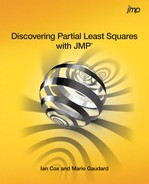References
Andersson, M. (2009), “A Comparison of Nine PLS1 Algorithms,” Journal of Chemometrics, 23:10, 518–529.
Arlot, S., and Celisse, A. (2010), “A Survey of Cross-Validation Procedures for Model Selection,” Statistics Surveys, 4, pp. 40–79.
Belsley, D.A. (1991), Conditioning Diagnostics: Collinearity and Weak Data in Regression, New York: Wiley-Interscience.
Chakrapani, C. (2004), Statistics in Market Research, London: Arnold.
Chatfield, C. (1995), Problem Solving: A Statistician’s Guide, 2d ed., New York: Chapman & Hall/CRC.
Chong, I.G., and Jun, C.H. (2005), “Performance of Some Variable Selection Methods When Multicollinearity is Present,” Chemometrics and Intelligent Laboratory Systems, 78:1-2, 103–112.
De Jong, S. (1993), “SIMPLS: An Alternative Approach to Partial Least Squares Regression,” Chemometrics and Intelligent Laboratory Systems, 18:3, 251–263.
Dijkstra, T.K. (2010), “Latent Variables and Indices: Herman Wold’s Basic Design and Partial Least Squares.” In Vinzi, V. E., Chin, W.W., Henseler, J., and Wang, H. (eds.), Handbook of Partial Least Squares: Concepts, Methods and Applications, Berlin: Springer, Chapter 1, 23–46.
Draper, N.R., and Smith, H. (1998), Applied Regression Analysis, 3d ed., New York: John Wiley & Sons, Inc.
Eriksson, L., Johansson, E., Kettaneh-Wold, N., Trygg, J., Wikstrom, C., and Wold, S. (2006), Multi- and Megavariate Data Analysis Basic Principles and Applications (Part I), Chapter 4, Umetrics.
Hastie, T., Tibshirani, R., and Friedman, J. (2001), The Elements of Statistical Learning: Data Mining, Inference, and Prediction, New York: Springer.
Hellberg, S., Sjöström, M., and Wold, S. (1986), “The Prediction of Bradykinin Potentiating Potency of Pentapeptides. An Example of a Peptide Quantitative Structure-activity Relationship,” Acta Chemica Scandinavica B, 40, 135–140.
Hoskuldsson, A. (1988), “PLS Regression Methods,” Journal of Chemometrics, 2:3, 211–228.
Kalivas, J.H. (1997), “Two Data Sets of Near Infrared Spectra,” Chemometrics and Intelligent Laboratory Systems, 37:2, 255–259.
Kourti, T., and MacGregor, J.F. (1996), “Multivariate SPC Methods for Process and Product Monitoring,” Journal of Quality Technology, 28:4, 409–428.
Mateos-Aparicio, G. (2011), “Partial Least Squares (PLS) Methods: Origins, Evolution, and Application to Social Sciences,” Communications in Statistics – Theory and Methods, 40:13, 2305–2317.
Microsoft Research (2009), The Fourth Paradigm: Data-Intensive Scientific Discovery, Hey, T., Tansley, S., and Tolle, K. (eds.), Microsoft Corporation.
Nash, M.S., and Chaloud, D.J. (2011), “Partial Least Square Analyses of Landscape and Surface Water Biota Associations in the Savannah River Basin,” International Scholarly Research Network, ISRN Ecology, Vol. 2011, Article ID 571749, 11 pages.
Nomikos, P., and MacGregor, J.F. (1995), “Multivariate SPC Charts for Monitoring Batch Processes,” Technometrics, 37:1, 41–59.
O’Mahony, M. (1986), Sensory Evaluation of Food: Statistical Methods and Procedures, New York: Marcel Dekker.
Pérez-Enciso, M., and Tenenhaus, M. (2003), “Prediction of Clinical Outcome with Microarray Data: A Partial Least Squares Discriminant Analysis (PLS-DA) Approach,” Human Genetics, 112:5-6, 581–592.
SAS Institute Inc. (2011), SAS/STAT 9.3 User’s Guide, “The PLS Procedure,” Cary, NC: SAS Institute Inc.
SAS Institute Inc. (2011), Using JMP, Cary, NC: SAS Institute Inc. For the most current version, go to http://www.jmp.com/support/downloads/documentation.shtml.
Sjöström, M., and Wold, S. (1985), “A Multivariate Study of the Relationship Between the Genetic Code and the Physical-Chemical Properties of Amino Acids,” Journal of Molecular Evolution, 22:3, 272–277.
Tabachnick, B.G., Fidell, L.S. (2001), Using Multivariate Statistics, Allyn and Bacon, Boston.
Tracy, N.D., Young, J.C., and Mason, R.L. (1992), “Multivariate Control Charts for Individual Observations,” Journal of Quality Technology, 24:2, 88–95.
Tobias, R.D. (1995), “An Introduction to Partial Least Squares Regression,” Proceedings of the Twentieth Annual SAS Users Group International Conference, Cary, NC: SAS Institute Inc.
Ufkes, J.G.R., Visser, B.J., Heuver, G., and Van der Meer, C. (1978), “Structure-Activity Relationships of Bradykinin Potentiating Peptides,” European Journal of Pharmacology, 50:2, 119–122.
Ufkes, J.G.R., Visser, B.J., Heuver, G., Wynne, H.J., and Van der Meer, C. (1982), “Further Studies on the Structure-Activity Relationships of Bradykinin-Potentiating Peptides,” European Journal of Pharmacology, 79:1-2, 155–158.
van den Wollenberg, A.L. (1977), “Redundancy Analysis - An Alternative for Canonical Correlation Analysis,” Psychometrika, 42:2, 207–219.
van der Voet, H. (1994), “Comparing the Predictive Accuracy of Models Using a Simple Randomization Test,” Chemometrics and Intelligent Laboratory Systems, 25:2, 313–323.
Wold, H. (1966), “Estimation of principal components and related models by iterative least squares.” In Krishnaiah, P.R. (ed.), Multivariate Analysis; Proceedings. New York: Academic Press, 391–420.
Wold, H. (1980). “Soft Modelling: Intermediate between Traditional Model Building and Data Analysis,” Mathematical Statistics (Banach Center Publications, Warsaw), 6, 333–346.
Wold, S. (1995), “PLS for Multivariate Linear Modeling,” in Chemometric Methods in Molecular Design. Methods and Principles in Medicinal Chemistry, van de Waterbeemd, H. (ed.), New York: VCH. [SAS Library Note: The second part of the title (Methods and Principles in Medicinal Chemistry) is actually the name of the Series.]
Wold, S., Johansson, E., and Cocchi, M. (1993), “PLS – Partial Least-Squares Projections to Latent Structures,” in 3D QSAR in Drug Design: Theory Methods and Applications, Vol.1, Kubinyi, H. (ed.), 523–550, Dordrecht, The Netherlands: Kluwer.
Wold, S., Sjostrom, M., Eriksson, L. (2001), “PLS-Regression: A Basic Tool of Chemometrics,” Chemometrics and Intelligent Laboratory Systems, 58:2, 109–130.
